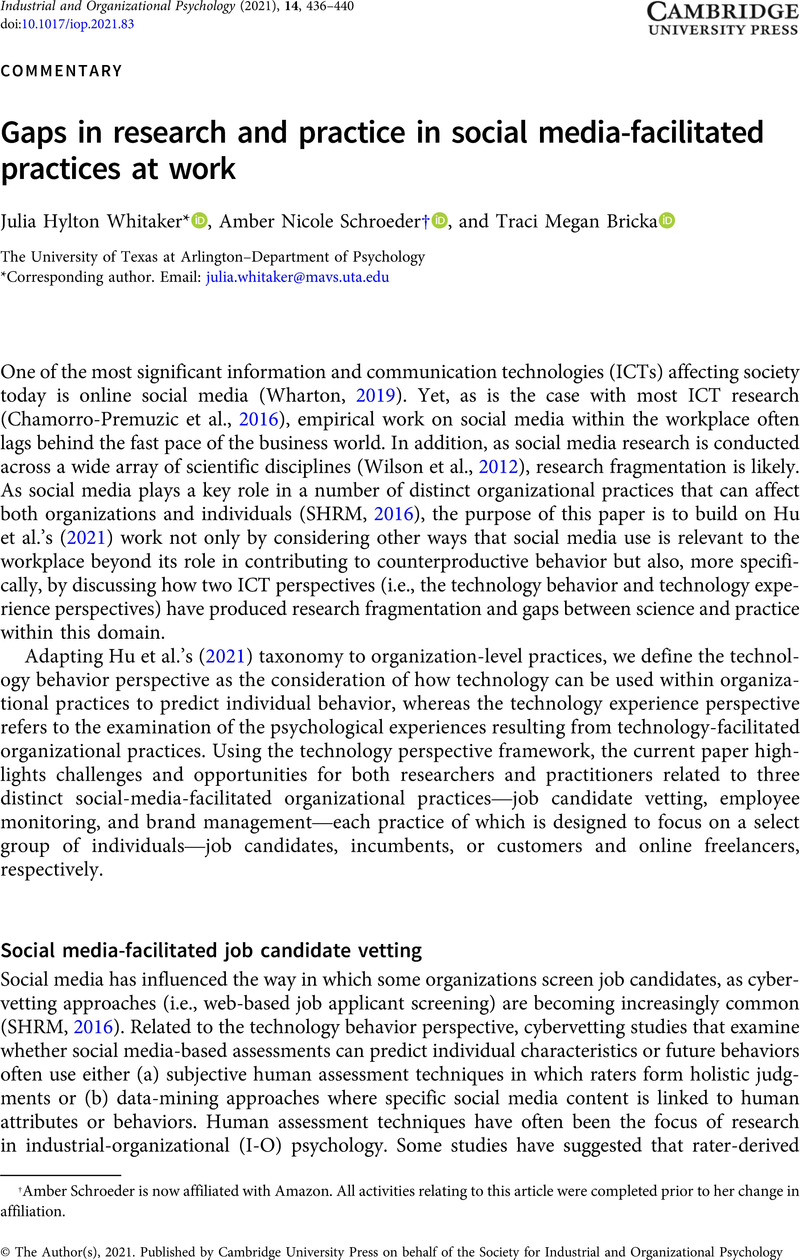No CrossRef data available.
Article contents
Gaps in research and practice in social media-facilitated practices at work
Published online by Cambridge University Press: 22 September 2021
Abstract
An abstract is not available for this content so a preview has been provided. Please use the Get access link above for information on how to access this content.

- Type
- Commentaries
- Information
- Copyright
- © The Author(s), 2021. Published by Cambridge University Press on behalf of the Society for Industrial and Organizational Psychology
Footnotes
†
Amber Schroeder is now affiliated with Amazon. All activities relating to this article were completed prior to her change in affiliation.
References
Bell, J. D. (2018, August 24). Firing for online behavior. SHRM. https://www.shrm.org/hr-today/news/hr-magazine/0918/pages/firing-for-online-behavior-.aspx
Google Scholar
Berkelaar, B. L. (2014). Cybervetting, online information, and personnel selection: New transparency expectations and the emergence of a digital social contract. Management Communication Quarterly, 28(4), 479–506. https://doi.org/10.1177/0893318914541966
CrossRefGoogle Scholar
Chamorro-Premuzic, T., Winsborough, D., Sherman, R. A., & Hogan, R. (2016). New talent signals: Shiny new objects or a brave new world? Industrial and Organizational Psychology: Perspectives on Science and Practice, 9(3), 621–640. https://doi.org/10.1017/iop.2016.6
CrossRefGoogle Scholar
Chatterjee, P. (2011). Drivers of new product recommending and referral behavior on social network sites. International Journal of Advertising, 30(1), 77–101. https://doi.org/10.2501/IJA-30-1-077-101
CrossRefGoogle Scholar
Davis, S. N., Shevchuk, A., & Strebkov, D. (2014). Pathways to satisfaction with work-life balance: The case of Russian-language Internet freelancers. Journal of Family and Economic Issues, 35(4), 542–556. https://doi.org/10.1007/s10834-013-9380-1
CrossRefGoogle Scholar
De Veirman, M., Cauberghe, V., & Hudders, L. (2017). Marketing through Instagram influencers: The impact of number of followers and product divergence on brand attitude. International Journal of Advertising, 36(5), 798–828. https://doi.org/10.1080/02650487.2017.1348035
CrossRefGoogle Scholar
Dunn, M., Stephany, F., Sawyer, S., Munoz, I., Raheja, R., Vaccaro, G., & Lehdonvirta, V. (2020). When motivation becomes desperation: Online freelancing during the COVID-19 pandemic. https://osf.io/preprints/socarxiv/67ptf/
CrossRefGoogle Scholar
Freberg, K., Graham, K., McGaughey, K., & Freberg, L. A. (2011). Who are the social media influencers? A study of public perceptions of personality. Public Relations Review, 37(1), 90–92. https://doi.org/10.1016/j.pubrev.2010.11.001
CrossRefGoogle Scholar
Godey, B., Manthiou, A., Pederzoli, D., Rokka, J., Aiello, G., Donvito, R., & Singh, R. (2016). Social media marketing efforts of luxury brands: Influence on brand equity and consumer behavior. Journal of Business Research, 69(12), 5833–5841. https://doi.org/10.1016/j.jbusres.2016.04.181
CrossRefGoogle Scholar
Hu, X., Barber, L K., Park, Y., & Day, A. (2021). Defrag and reboot? Consolidating information and communication technology research in I-O psychology. Industrial and Organizational Psychology: Perspectives on Science and Practice, 14(3), 371–396.Google Scholar
Kluemper, D. H., Rosen, P. A., & Mossholder, K. W. (2012). Social networking websites, personality ratings, and the organizational context: More than meets the eye? Journal of Applied Social Psychology, 42(5), 1143–1172. https://doi.org/10.1111/j.1559-1816.2011.00881.x
CrossRefGoogle Scholar
Kosinski, M., Stillwell, D., & Graepel, T. (2013). Private traits and attributes are predictable from digital records of human behavior. Proceedings of the National Academy of Sciences–PNAS, 110(15), 5802–5805. https://doi.org/10.1073/pnas.1218772110
CrossRefGoogle ScholarPubMed
Lam, H. (2016). Social media dilemmas in the employment context. Employee Relations, 38(3), 420–437. https://doi.org/10.1108/ER-04-2015-0072
CrossRefGoogle Scholar
Ravid, D. M., Tomczak, D. L., White, J. C., & Behrend, T. S. (2020). EPM 20/20: A review, framework, and research agenda for electronic performance monitoring. Journal of Management, 46(1), 100–126. https://doi.org/10.1177/0149206319869435
CrossRefGoogle Scholar
Roulin, N., & Levashina, J. (2016). Impression management and social media profiles. In Landers, N. R. & Schmidt, B. G. (Eds.), Social media in employee selection and recruitment: Theory, practice, and current challenges (pp. 223–248). Springer International Publishing.Google Scholar
Sayre, G. M., & Dahling, J. J. (2016). Surveillance 2.0: How personality qualifies reactions to social media monitoring policies. Personality and Individual Differences, 90, 254–259. https://doi.org/10.1016/j.paid.2015.11.021
CrossRefGoogle Scholar
Schroeder, A. N., & Lile, C. R. (2016). Legal trends in organizational online social media use. Industrial and Organizational Psychology: Perspectives on Science and Practice, 9(3), 682–689. https://doi.org/10.1017/iop.2016.71
CrossRefGoogle Scholar
Society for Human Resource Management (SHRM). (2016, January 19). Managing and leveraging workplace use of social media. https://www.shrm.org/resourcesandtools/tools-and-samples/toolkits/pages/managingsocialmedia.aspx
Google Scholar
Stoughton, J. W., Thompson, L. F., & Meade, A. W. (2015). Examining applicant reactions to the use of social networking websites in pre-employment screening. Journal of Business and Psychology, 30(1), 73–88. https://doi.org/10.1007/s10869-013-9333-6
CrossRefGoogle Scholar
Sutherland, W., Jarrahi, M. H., Dunn, M., & Nelson, S. B. (2020). Work precarity and gig literacies in online freelancing. Work, Employment and Society, 34(3), 457–475. https://doi.org/10.1177/0950017019886511
CrossRefGoogle Scholar
Toropin, K., & Asmelash, L. (2020, November 30). Nurse put on administrative leave after her TikTok bragging about breaking COVID-19 rules goes viral. CNN. https://www.cnn.com/2020/11/30/us/tik-tok-nurse-viral-salem-hospital-trnd/index.html
Google Scholar
Umphress, E. E., Tihanyi, L., Bierman, L., & Gogus, C. I. (2013). Personal lives? The effects of nonwork behaviors on organizational image. Organizational Psychology Review, 3(3), 199–221. https://doi.org/10.1177/2041386612473014
CrossRefGoogle Scholar
Van Iddekinge, C. H., Lanivich, S. E., Roth, P. L., & Junco, E. (2016). Social media for selection? Validity and adverse impact potential of a Facebook-based assessment. Journal of Management, 42(7), 1811–1835. https://doi.org/10.1177/0149206313515524
CrossRefGoogle Scholar
Weissmann, J. (2018, October 10). Amazon created a hiring tool using A.I. It immediately started discriminating against women. Slate. https://slate.com/business/2018/10/amazon-artificial-intelligence-hiring-discrimination-women.html
Google Scholar
Wharton. (2019, July 26). The impact of social media: Is it irreplaceable? University of Pennsylvania. https://knowledge.wharton.upenn.edu/article/impact-of-social-media/
Google Scholar
Willford, J. C. (2019, July 17). Enhancing judgment: The case for human-algorithm collaboration. Society for Industrial-Organizational Psychology. https://www.siop.org/Research-Publications/Items-of-Interest/ArtMID/19366/ArticleID/3059/Enhancing-Judgment-The-Case-for-Human-Algorithm-Collaboration
Google Scholar
Wilson, R. E., Gosling, S. D., & Graham, L. T. (2012). A review of Facebook research in the social sciences. Perspectives on Psychological Science, 7(3), 203–220. https://doi.org/10.1177/1745691612442904
CrossRefGoogle ScholarPubMed
Youyou, W., Kosinski, M., & Stillwell, D. (2015). Computer-based personality judgments are more accurate than those made by humans. Proceedings of the National Academy of Sciences–PNAS, 112(4), 1036–1040. https://doi.org/10.1073/pnas.1418680112
CrossRefGoogle ScholarPubMed




